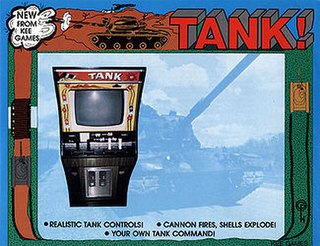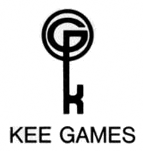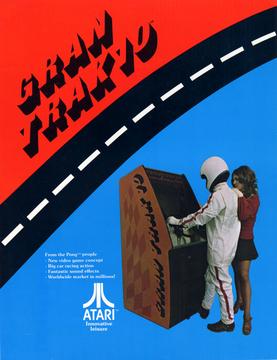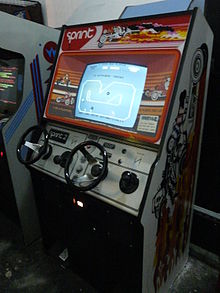Racing games are a video game genre in which the player participates in a racing competition. They may be based on anything from real-world racing leagues to fantastical settings. They are distributed along a spectrum between more realistic racing simulations and more fantastical arcade-style racing games. Kart racing games emerged in the 1990s as a popular sub-genre of the latter. Racing games may also fall under the category of sports video games.
A sports video game is a video game that simulates the practice of sports. Most sports have been recreated with video games, including team sports, track and field, extreme sports, and combat sports. Some games emphasize playing the sport, whilst others emphasize strategy and sport management. Some, such as Need for Speed, Arch Rivals and Punch-Out!!, satirize the sport for comic effect. This genre has been popular throughout the history of video games and is competitive, just like real-world sports. A number of game series feature the names and characteristics of real teams and players, and are updated annually to reflect real-world changes. The sports genre is one of the oldest genres in gaming history.

Breakout is an arcade video game developed and published by Atari, Inc. and released on May 13, 1976. It was designed by Steve Wozniak, based on conceptualization from Nolan Bushnell and Steve Bristow, who were influenced by the seminal 1972 Atari arcade game Pong. In Breakout, a layer of bricks lines the top third of the screen and the goal is to destroy them all by repeatedly bouncing a ball off a paddle into them. The arcade game was released in Japan by Namco. Breakout was a worldwide commercial success, among the top five highest-grossing arcade video games of 1976 in both the United States and Japan and then among the top three highest-grossing arcade video games of 1977 in the US and Japan. The 1978 Atari VCS port uses color graphics instead of a monochrome screen with colored overlay.

Super Sprint is a racing video game released by Atari Games and Midway Games in 1986. Up to three players drive Formula One-like cars on a circuit that is viewed from above. The game is a successor to Gran Trak 10 and the Sprint series, which were black-and-white games from the 1970s. A sequel, Championship Sprint, was released later in the same year.

Night Driver is an arcade video game developed by Atari, Inc. and released in the United States in October 1976. It's one of the earliest first-person racing video games and is commonly believed to be one of the first published video games to feature real-time first-person graphics. Night Driver has a black and white display with the hood of the player's car painted on a plastic overlay. The road is rendered as scaled rectangles representing "pylons" that line the edges.

Gun Fight, known as Western Gun in Japan and Europe, is a 1975 multidirectional shooter arcade video game designed by Tomohiro Nishikado, and released by Taito in Japan and Europe and by Midway in North America. Based around two Old West cowboys armed with revolvers and squaring off in a duel, it was the first video game to depict human-to-human combat. The Midway version was also the first video game to use a microprocessor instead of TTL. The game's concept was adapted from Sega's 1969 arcade electro-mechanical game Gun Fight.
1977 had sequels such as Super Speed Race and Datsun 280 ZZZAP as well as several new titles such as Space Wars. The year's highest-grossing arcade games were F-1 and Speed Race DX in Japan, and Sea Wolf and Sprint 2 in the United States. The year's best-selling home system was Nintendo's Color TV-Game, which was only sold in Japan.
1974 had new titles such as Speed Race, Gran Trak 10, Tank and TV Basketball. The year's best-selling arcade game was Tank by Kee Games.

Atlantis is a fixed shooter video game released by Imagic in July 1982 for the Atari 2600. It was written by Dennis Koble who also wrote Trick Shot, Solar Storm, and Shootin' Gallery for Imagic. Atlantis was ported to the Atari 8-bit computers, VIC-20, Intellivision, and Magnavox Odyssey 2. The game was inspired by Taito's 1981 Colony 7 arcade game.

Tank is an arcade game developed by Kee Games, a subsidiary of Atari, and released in November 1974. It was one of the few original titles not based on an existing Atari property developed by Kee Games, which was founded to sell clones of Atari games to distributors as a fake competitor prior to the merger of the two companies. In the game, two players drive tanks through a maze viewed from above while attempting to shoot each other and avoid mines, represented by X marks, in a central minefield. Each player controls their tank with a pair of joysticks, moving them forwards and back to drive, reverse, and steer, and firing shells with a button to attempt to destroy the other tank. The destruction of a tank from a mine or shell earns the opposing player a point, and tanks reappear after being destroyed. The winner is the player with more points when time runs out, with each game typically one or two minutes long.

Kee Games was an American arcade game manufacturer that released arcade and video games from 1973 to 1978.

Gran Trak 10 is an arcade driving video game developed by Atari through its subsidiary Cyan Engineering, and released by Atari in May 1974. In the game, a single player drives a car along a race track, viewed from above, avoiding walls of pylons and trying to pass as many checkpoints as possible before time runs out. The game is controlled with a steering wheel, accelerator and brake pedals, and a gear stick, and the car crashes and spins if it hits a pylon.

Sea Wolf is an arcade video game designed by Dave Nutting and released by Midway in 1976. It is a video game update of an electro-mechanical Midway game, Sea Devil, itself based on Sega's 1966 electro-mechanical arcade submarine simulator Periscope. The game was released in Japan by Taito. In Sea Wolf, the player, piloting an unseen submarine, launches torpedoes vertically in an attempt to sink ships moving horizontally across the screen before time runs out. The screen is viewed through a faux periscope mounted on the cabinet.

Dominos is a one, two or four-player video action game packaged in its own distinctively styled upright cabinet that rest directly on the floor.

F-1 is a 1976 electro-mechanical arcade racing game developed and published by Nakamura Manufacturing Company (Namco), and distributed in North America by Atari, Inc. The player uses a steering wheel to control a Formula One racer, which must avoid collision with other vehicles. The game uses a miniature diorama with small, plastic cars to represent the player's car and opponents on a physical, rotating track, while also featuring a projector system and lighting tricks to create the illusion of racing.

Circus is a block breaker arcade video game released by Exidy in 1977, and distributed by Taito in Japan. The game is a re-themed variant of Atari, Inc.'s Breakout, where the player controls a seesaw and clown in order to pop all the balloons in the level. The game has been copied and released under different names by numerous other companies in both the United States and Japan.

Football is a 1978 American football video game developed and released by Atari, Inc. for arcades. Players are represented by Xs and Os. While predated by Sega's World Cup, Football is credited with popularizing the trackball controller and is also the first non-racing vertically scrolling video game. It distributed in Japan by Namco in 1979.

Speed Race is a 1974 arcade racing video game developed and manufactured by Taito and released under the titles Racer and Wheels in North America by distributor Midway Manufacturing in 1975. Designed by Tomohiro Nishikado, the gameplay involves the player using the attached steering wheel to maneuver a car alongside a fast vertical scrolling road. The objective is to score points by driving past other cars without colliding with them; more points are awarded for driving faster. Players must do this under a 90-second time limit, which ends the game when it runs out. The gameplay concepts were adapted from two earlier driving electro-mechanical games: Kasco's Mini Drive (1958) and Taito's Super Road 7 (1970).
Electro-mechanical games are types of arcade games that operate on a combination of some electronic circuitry and mechanical actions from the player to move items contained within the game's cabinet. Some of these were early light gun games using light-sensitive sensors on targets to register hits, while others were simulation games such as driving games, combat flight simulators and sports games. EM games were popular in amusement arcades from the late 1940s up until the 1970s, serving as alternatives to pinball machines, which had been stigmatized as games of chance during that period. EM games lost popularity in the 1970s, as arcade video games had emerged to replace them in addition to newer pinball machines designed as games of skill.

LeMans is a single-player race game created by Atari, Inc. in 1976. It was distributed in Japan by Namco. It is the successor to the Gran Trak 10 and Gran Track 20 video games.














